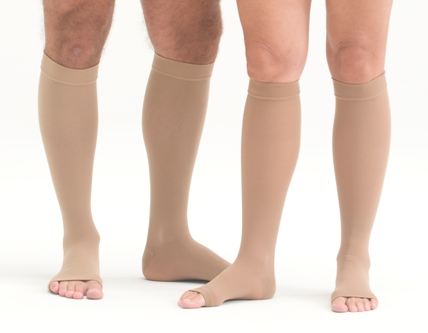Edema is the abnormal accumulation of fluid under the skin, which most commonly affects circulation of the lower legs, ankles and feet. Compression stockings are used to help improve this inefficient blood flow caused by edema. There are numerous causes for edema, including but not limited to, varicose veins, sports injuries, standing or sitting for prolonged time periods, pregnancy or surgery. Besides, compression stockings come in various styles, colors and patterns, which are both stylish and effective.
How Do Compression Stockings Benefit Edema?
Compression stockings are firm, elastic socks that provide measured pressure to your lower legs. The socks provide a firm grip on the ankles and relax pressure as they run up the legs.
 Compression stockings can be extremely beneficial in helping with edema by preventing the buildup of fluid in the tissue. They are designed to apply the right amount of compression up and across the legs to help improve blood flow, the pressure forcing the blood to circulate back to the heart, decreasing its accumulation in the lower leg.
Compression stockings can be extremely beneficial in helping with edema by preventing the buildup of fluid in the tissue. They are designed to apply the right amount of compression up and across the legs to help improve blood flow, the pressure forcing the blood to circulate back to the heart, decreasing its accumulation in the lower leg.
Compression stockings should be worn throughout the day but removed at night, which has been proven to reduce leg swelling, making compression stockings edema treatment more helpful.
How to Choose the Best Fit Compression Stockings
If you have been advised to use compression stockings to treat edema, then it's important to think what will be the best fit for you. First thing first, you must know all different types of compression stockings and their features.
Compression products, like compression stockings, are usually measured in mmHg (millimeters of mercury). Compression stockings range from extra-firm compression at their most extreme to mild compression at the opposite end of the spectrum. Here are 4 types of them:
- Mild compression is used for minor conditions and is measured at 8-15 mmHg.
- Moderate compression measures at 15-20 mmHg and is often used for mild to moderate leg swelling and mild leg pain.
- Firm compression, a type of compression stocking edema treatment, applies firm pressure, which measures at 20-10 mmHg. It can be used to treat mild to moderate leg soreness and moderate swelling. Besides, it can also prevent relapse of leg venous ulcers.
- Extra-firm compression, measuring about 30-40 mmHg, can be applied to help promote blood flow in case of extreme swelling and severe edema, especially for people with diabetes.
Now you have known the types of compression stockings, then if you want to find the best fit, you should next determine how much compression you need, which means ascertaining the extent and severity of your condition. Deciding what compression stocking will work best for you will help release leg swelling and edema. It is always advisable to use the lowest amount of pressure and compression that is required to treat a condition. If you have never worn compression stockings in the past, then you shouldn't go straight for extra-firm compression. If you are unsure as to what level of pressure will best treat your condition, consult your health care professional for further advice and help with your decision.
How to Put on Your Compression Stockings
Compression stockings can be difficult to get on. They are basically put on in the same way as normal socks, yet more difficult due to the increased pressure and compression implemented in their design. The higher the compression is, the more difficult to put it on.
Some often apply baby powder, or a similar substance, to help ease the process. If your arm strength is permitting, roll the stocking from the top to the heel and then place your foot inside as far as possible. Once inserted, roll the stocking up your leg until it is firmly on. Ensure the stockings are straight and smooth them with your hands to remove any creases.
Tips on Taking Care of Your Compression Stocking
If you are using the compression stocking edema treatment, then it is important to remember to change you compression stockings every 3 to 6 months to ensure you are consistently receiving the support required. It is important to keep your compression stockings clean and wash them with detergent when needed.
- Wash with washing machine: Most compression stockings can be cleaned in a washing machine on the delicate setting, although it is advisable to avoid using fabric conditioner, as this can affect the effectiveness of the compression stockings.
- Hand washing: Simply fill a sink or bowl with water and add the detergent/washing powder. Leave the socks to soak for a short time before you wash them. Once washed, ensure you rinse them to remove any excess liquid. You can wrap the socks in a towel to make a package and apply pressure to the package to remove as much moisture as possible. This can also be done by placing the package on the ground and standing on it to tread it flat. At last, remove the stockings from the packaged towel and hand them up to dry.
